Do you have a question about the Yamaha WR450F 2022 and is the answer not in the manual?
Essential safety guidelines and precautions for operating the vehicle.
Identifies the location of critical labels on the vehicle.
Overview of the vehicle's main parts and components.
Details on vehicle identification numbers and labels.
Lists and describes parts included with the vehicle.
Crucial notes regarding preparation, disassembly, and replacement parts.
Explanation of the vehicle's instruments and controls.
Guide to operating and setting the multi-function display.
Procedures for starting the engine and initial break-in period.
Recommended maintenance checks after the break-in period.
Lists critical torque specifications for various components.
Guidelines for cleaning, maintaining, and storing the motorcycle.
Key dimensions, weight, and performance specifications of the vehicle.
Detailed technical data for the engine and its components.
Technical data for the chassis, suspension, and braking systems.
Specifications for the battery, lights, and electrical system components.
General and specific torque values for fasteners and assembly.
Schedule and procedures for regular maintenance tasks.
Pre-ride checks and essential maintenance tasks.
Procedures for checking and adjusting engine components.
Procedures for checking and adjusting chassis components like brakes and suspension.
Checks and maintenance for the vehicle's electrical system.
Procedures for removing and installing major chassis parts like seat and covers.
Steps for removing, installing, and checking the front wheel.
Steps for removing, installing, and checking the rear wheel and sprocket.
Procedures for replacing front brake pads and checking system.
Procedures for replacing rear brake pads and checking system.
Steps for removing, installing, and adjusting the handlebar.
Detailed procedures for disassembling, checking, and assembling front forks.
Procedures for checking, replacing, and installing steering head components.
Steps for removing and checking the rear shock absorber.
Procedure for removing and checking the swingarm.
Instructions for maintaining the drive chain, sprockets, and installation.
Procedures for installing the exhaust pipe and muffler.
Steps for removing, checking, and installing clutch components.
Procedures for removing and installing the fuel tank.
Information on the ECU self-diagnostic function and warning lights.
Procedures for checking bulbs, fuses, and the battery.
General guidance and tips for effective troubleshooting.
Diagnosing engine starting and running issues without fault codes.
Diagnosing common clutch problems like slippage, drag, and noise.
Identifying causes for shifting difficulties, jumps, and noise.
Diagnosing and resolving overheating and water pump noise issues.
Identifying causes for poor disc brake performance.
Diagnosing issues with front and rear suspension stiffness and leaks.
Troubleshooting handlebar wobble, heavy steering, and wheel vibration.
Diagnosing issues with the battery charge.
Troubleshooting common lighting system failures.
Diagnosing issues with indicator lights and speedometer.
Table of fault codes for the fuel injection system.
Adjusting gear ratio for optimal performance based on track conditions.
Lists parts for drive and rear wheel sprocket setup.
Adjusting tire pressure based on road surface conditions for optimal grip.
Adjusting front fork characteristics for rider feel and circuit conditions.
Modifying damping by changing fork oil quantity.
Adjusting front fork settings after spring replacement.
Details on front fork spring types and part numbers.
Adjusting rear suspension preload and damping based on rider feel.
Measuring and adjusting spring length for rear suspension setup.
Lists rear shock absorber spring types, part numbers, and ID marks.
Table of symptoms, checks, and adjustments for front fork suspension.
Table of symptoms, checks, and adjustments for rear shock absorber suspension.
Essential safety guidelines and precautions for operating the vehicle.
Identifies the location of critical labels on the vehicle.
Overview of the vehicle's main parts and components.
Details on vehicle identification numbers and labels.
Lists and describes parts included with the vehicle.
Crucial notes regarding preparation, disassembly, and replacement parts.
Explanation of the vehicle's instruments and controls.
Guide to operating and setting the multi-function display.
Procedures for starting the engine and initial break-in period.
Recommended maintenance checks after the break-in period.
Lists critical torque specifications for various components.
Guidelines for cleaning, maintaining, and storing the motorcycle.
Key dimensions, weight, and performance specifications of the vehicle.
Detailed technical data for the engine and its components.
Technical data for the chassis, suspension, and braking systems.
Specifications for the battery, lights, and electrical system components.
General and specific torque values for fasteners and assembly.
Schedule and procedures for regular maintenance tasks.
Pre-ride checks and essential maintenance tasks.
Procedures for checking and adjusting engine components.
Procedures for checking and adjusting chassis components like brakes and suspension.
Checks and maintenance for the vehicle's electrical system.
Procedures for removing and installing major chassis parts like seat and covers.
Steps for removing, installing, and checking the front wheel.
Steps for removing, installing, and checking the rear wheel and sprocket.
Procedures for replacing front brake pads and checking system.
Procedures for replacing rear brake pads and checking system.
Steps for removing, installing, and adjusting the handlebar.
Detailed procedures for disassembling, checking, and assembling front forks.
Procedures for checking, replacing, and installing steering head components.
Steps for removing and checking the rear shock absorber.
Procedure for removing and checking the swingarm.
Instructions for maintaining the drive chain, sprockets, and installation.
Procedures for installing the exhaust pipe and muffler.
Steps for removing, checking, and installing clutch components.
Procedures for removing and installing the fuel tank.
Information on the ECU self-diagnostic function and warning lights.
Procedures for checking bulbs, fuses, and the battery.
General guidance and tips for effective troubleshooting.
Diagnosing engine starting and running issues without fault codes.
Diagnosing common clutch problems like slippage, drag, and noise.
Identifying causes for shifting difficulties, jumps, and noise.
Diagnosing and resolving overheating and water pump noise issues.
Identifying causes for poor disc brake performance.
Diagnosing issues with front and rear suspension stiffness and leaks.
Troubleshooting handlebar wobble, heavy steering, and wheel vibration.
Diagnosing issues with the battery charge.
Troubleshooting common lighting system failures.
Diagnosing issues with indicator lights and speedometer.
Table of fault codes for the fuel injection system.
Adjusting gear ratio for optimal performance based on track conditions.
Lists parts for drive and rear wheel sprocket setup.
Adjusting tire pressure based on road surface conditions for optimal grip.
Adjusting front fork characteristics for rider feel and circuit conditions.
Modifying damping by changing fork oil quantity.
Adjusting front fork settings after spring replacement.
Details on front fork spring types and part numbers.
Adjusting rear suspension preload and damping based on rider feel.
Measuring and adjusting spring length for rear suspension setup.
Lists rear shock absorber spring types, part numbers, and ID marks.
Table of symptoms, checks, and adjustments for front fork suspension.
Table of symptoms, checks, and adjustments for rear shock absorber suspension.
| Engine Type | Liquid-cooled, 4-stroke, DOHC, 4-valve |
|---|---|
| Displacement | 449cc |
| Bore x Stroke | 97.0 mm x 60.8 mm |
| Compression Ratio | 13.0:1 |
| Fuel System | Fuel Injection |
| Ignition | TCI: Transistor Controlled Ignition |
| Final Drive | Chain |
| Front Suspension | KYB® Speed-Sensitive System inverted fork; fully adjustable, 12.2-in travel |
| Rear Suspension | KYB® single shock; fully adjustable, 12.5-in travel |
| Front Brake | Hydraulic disc, 270mm |
| Length | 85.6 in |
| Width | 32.5 in |
| Height | 50.0 in |
| Seat Height | 37.6 in |
| Wheelbase | 58.3 in |
| Ground Clearance | 12.8 in |
| Wet Weight | 262 lb |
| Transmission | 5-speed; multiplate wet clutch |
| Front Tire | 80/100-21 |
| Rear Tire | 120/90-18 |
| Fuel Delivery | Yamaha Fuel Injection (YFI) with 44mm Mikuni® throttle body |
| Rear Brake | Hydraulic disc, 245mm |
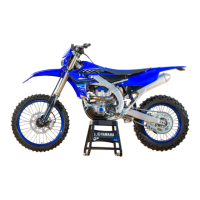
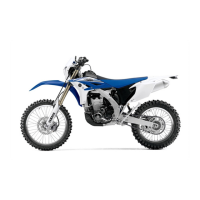
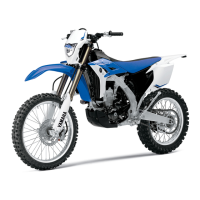
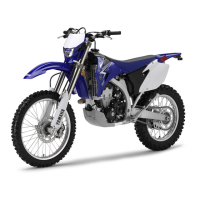
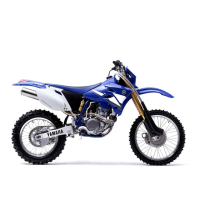

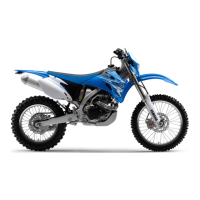

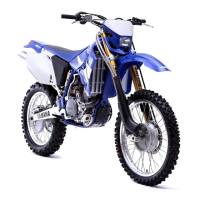
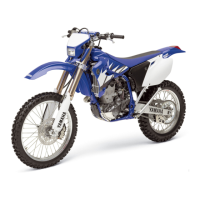

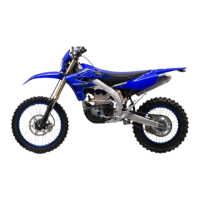
